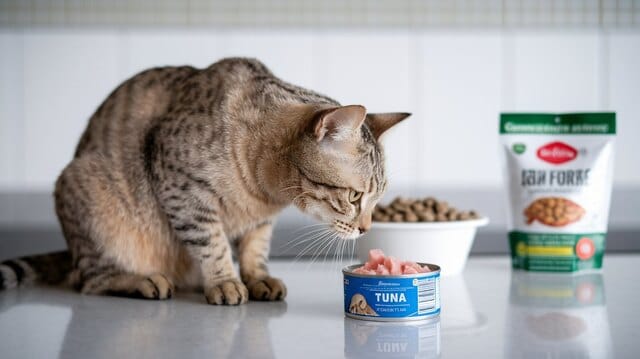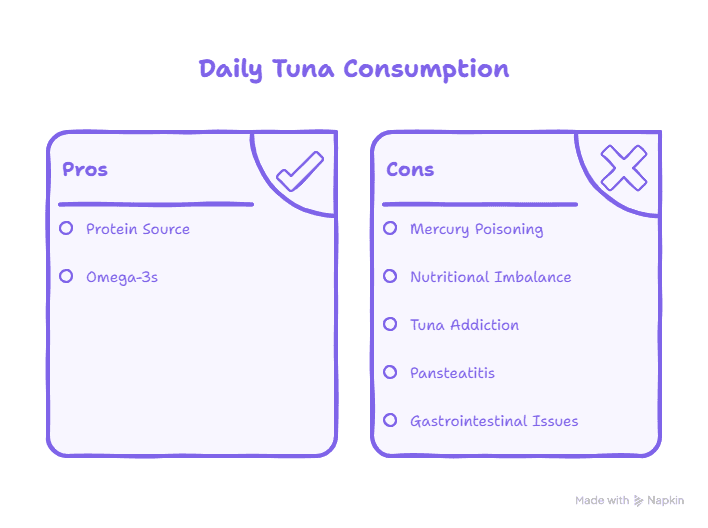
Introduction
If you’ve ever popped open a can of tuna and watched your cat appear out of thin air, you know the power of that scent. For many cats, tuna is the ultimate treat—it’s rich, flavorful, and practically irresistible.
So it’s no surprise that cat parents often ask:
“Can cats eat tuna every day?”
The short answer: No, it’s not recommended.
While tuna isn’t inherently toxic to cats, feeding it daily can lead to health issues over time.
In this comprehensive guide, we’ll explore why cats love tuna, the dangers of overfeeding, how much is safe, and healthier alternatives to keep your kitty both happy and healthy.
Why Do Cats Love Tuna So Much?
Before we get into the risks, let’s understand the attraction. Tuna is:
- High in protein and fat
- Strong-smelling and flavorful
- Often found in wet food and treats
- Sometimes used to hide medication or tempt picky eaters
Its rich aroma and taste can be addictive, especially for cats who love variety or are naturally food-motivated. But just because they want it doesn’t mean it’s the best choice every day.
Can Cats Eat Tuna Every Day?
Here’s the truth:
Feeding your cat tuna every day is not safe or nutritionally balanced.
Tuna—especially the kind made for humans—lacks many essential nutrients that cats need, including:
- Taurine (for heart and vision health)
- Vitamin E
- Calcium and other minerals
- Balanced ratios of fatty acids
Even tuna-flavored cat foods are carefully formulated to meet nutritional standards, not just packed with pure tuna.
So while tuna can be an occasional treat, it should not replace your cat’s regular, balanced meals.
Health Risks of Feeding Tuna Daily

Giving your cat a bite of tuna now and then is usually fine, but daily tuna feeding? That’s where things get risky.
Let’s look at the potential health issues that can arise.
⚠️ 1. Mercury Poisoning
Just like humans, cats can suffer from mercury toxicity if they consume too much tuna over time.
Tuna, especially larger species like albacore, accumulate mercury in their flesh.
Signs of mercury poisoning in cats may include:
- Lack of coordination or balance
- Muscle tremors or twitching
- Weakness or fatigue
- Loss of appetite
- Behavioral changes
While rare, chronic exposure over months or years increases the risk significantly.
⚠️ 2. Nutritional Imbalance
Tuna doesn’t provide the complete amino acid and vitamin profile cats require. Cats are obligate carnivores, and their diet must include:
- Taurine for heart and eye function
- Vitamin E to protect against oxidative stress
- Calcium and phosphorus in proper balance for bone health
A tuna-heavy diet, especially if it replaces commercial cat food, can lead to deficiencies, organ stress, and poor coat quality.
⚠️ 3. Tuna Addiction (Food Fixation)
Yes, it’s a thing.
Cats can develop a strong preference—or addiction—to tuna, especially if they’re offered it frequently. Eventually, they may:
- Refuse other foods
- Beg for tuna constantly
- Become undernourished from a narrow diet
This creates a frustrating cycle for cat parents and makes transitioning back to a balanced diet difficult.
⚠️ 4. Pansteatitis (Yellow Fat Disease)
Tuna is high in unsaturated fats and low in Vitamin E, which can lead to a condition called pansteatitis—a painful inflammation of the body’s fat tissue.
Symptoms include:
- Lethargy
- Painful movement
- Depression or loss of appetite
- Sensitivity to touch (especially abdomen)
It’s rare but serious, and often triggered by frequent tuna feeding.
⚠️ 5. Gastrointestinal Issues
Tuna, particularly canned tuna in oil, is rich and oily. If given too often, it can upset your cat’s digestive system.
Watch for:
- Diarrhea
- Vomiting
- Flatulence
- Reduced appetite after eating tuna
Some cats tolerate tuna better than others, but moderation is always the safer path.
Is Canned Tuna Safe for Cats?
Canned tuna for humans is not toxic, but it should be offered with caution.
✅ Safe Choices:
- Water-packed tuna
- No added salt or seasoning
- No garlic or onion (even traces are toxic to cats)
❌ Avoid:
- Tuna in oil (too rich and fatty)
- Tuna with flavoring (lemon, chili, herbs)
- Salted or smoked tuna
- Leftover tuna with condiments or sauces
Always check the label before offering tuna, even small amounts.
How Much Tuna Is Safe for a Cat?
Veterinarians typically recommend that tuna should make up no more than 10% of your cat’s total diet.
A safe serving size:
- 1–2 teaspoons per meal
- No more than 1–2 times per week
- Only as a treat, not a primary protein source
Treat tuna like you would a snack—it’s okay occasionally, but it’s not a meal replacement.
What About Tuna in Cat Food?
Tuna flavored or tuna-based commercial cat foods are different from pure canned tuna.
These are formulated to include:
- Taurine
- Essential vitamins and minerals
- Proper fat and protein ratios
If your cat enjoys tuna flavor, choose a wet or dry food from a reputable brand that lists tuna as an ingredient but ensures full nutritional balance.
Still, variety is important. Rotate proteins like:
- Chicken
- Turkey
- Duck
- Salmon
- Rabbit
A diverse diet supports better digestion and reduces picky eating habits.
Can Kittens Eat Tuna?
Kittens should not be fed tuna regularly. Their growing bodies require:
- More calories
- More calcium and phosphorus
- A balanced, high-protein kitten formula
Occasional licks won’t harm them, but frequent tuna feeding can disrupt growth and organ development.
Better Alternatives to Daily Tuna
You can still spoil your cat—just with safer options! Here are some healthier tuna alternatives:
🧊 Freeze-Dried Treats
- Made from single-ingredient meats (chicken, turkey, salmon)
- High in protein
- Low in fat and carbs
- No preservatives or additives
🐔 Cooked Chicken or Turkey
- Boiled or baked, unseasoned
- Rich in lean protein
- Easier to digest than tuna
🍲 Tuna-Flavored Cat Food
- Look for balanced formulas with tuna flavor, not pure tuna
- Choose grain-free, high-protein varieties if possible
🐟 Commercial Cat Tuna Treats
- Brands like Tiki Cat, Applaws, or Sheba make cat-safe tuna snacks
- Often portioned in small quantities
- Safer than sharing human-grade tuna
When to Call the Vet
If your cat shows any of the following symptoms after regular tuna consumption, contact your vet:
- Loss of coordination or balance
- Refusal to eat normal food
- Excessive meowing or begging for tuna
- Yellowish discoloration of skin
- Diarrhea, vomiting, or bloating
- Lethargy or hiding behavior
Early intervention can prevent long-term complications.
FAQs
Can cats eat tuna in oil?
No. Tuna in oil is high in fat and can cause digestive upset. Always choose water-packed and unseasoned.
Can tuna help with picky eaters or sick cats?
In small amounts, yes. Tuna can stimulate appetite, but don’t let it replace full meals. Use tuna to entice, not substitute.
Can I give tuna to my cat every other day?
Still not recommended. Even every other day is too frequent and can lead to fixation or nutritional imbalance.
What’s the best way to give tuna safely?
- Choose water-packed, unsalted tuna
- No spices, sauces, or garlic
- Serve no more than 1–2 times weekly
- Offer as a topper or tiny treat—not a meal
Also Read - Why Does My Cat Stare at the Wall? Uncovering the Mystery Behind the Blank Gaze
Conclusion
So, can cats eat tuna every day?
No, and they shouldn’t.
While cats may love tuna like it’s the greatest thing in the world, feeding it daily opens the door to:
- Mercury exposure
- Nutritional imbalances
- Food addiction
- Digestive and inflammatory conditions
That said, tuna can still be a safe, special treat when served correctly, once or twice a week, in small amounts, and never as a meal replacement.
If your cat is tuna-obsessed, don’t worry—you’re not alone. With a little patience and the right alternatives, you can keep their meals balanced and their cravings satisfied.
Because a healthy cat isn’t just a happy cat—it’s a longer-living companion who gets the best of both worlds: great food and great care.




